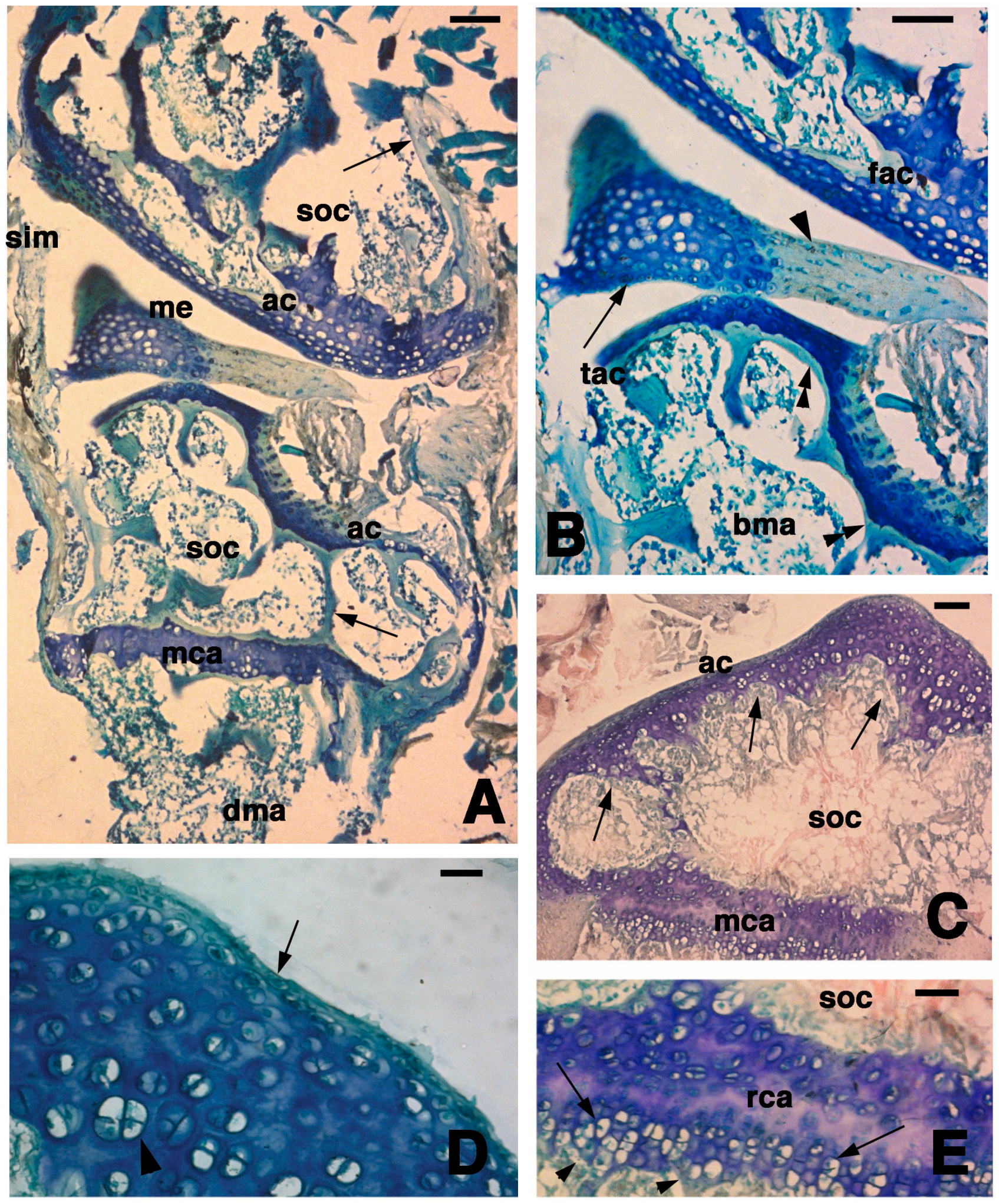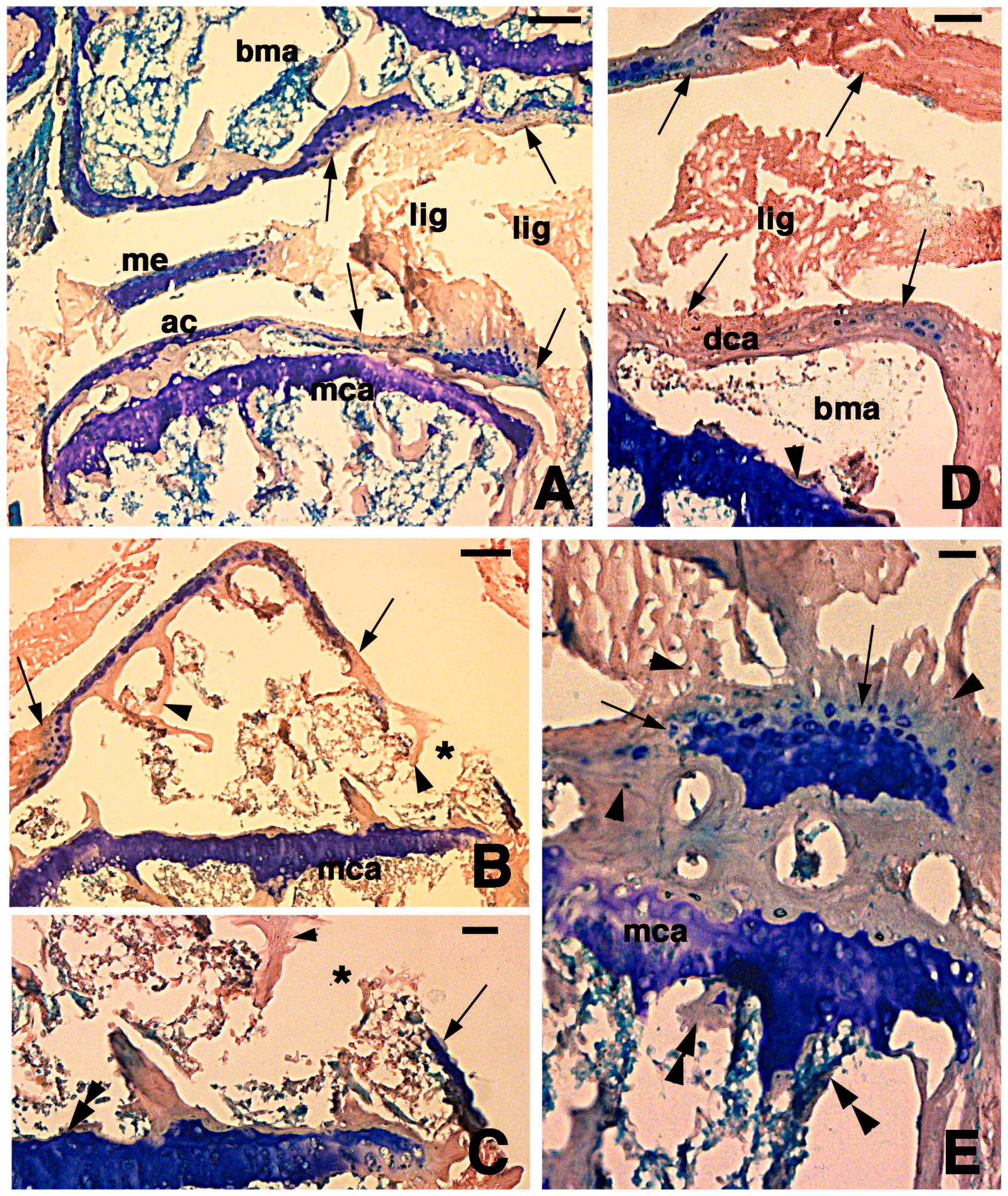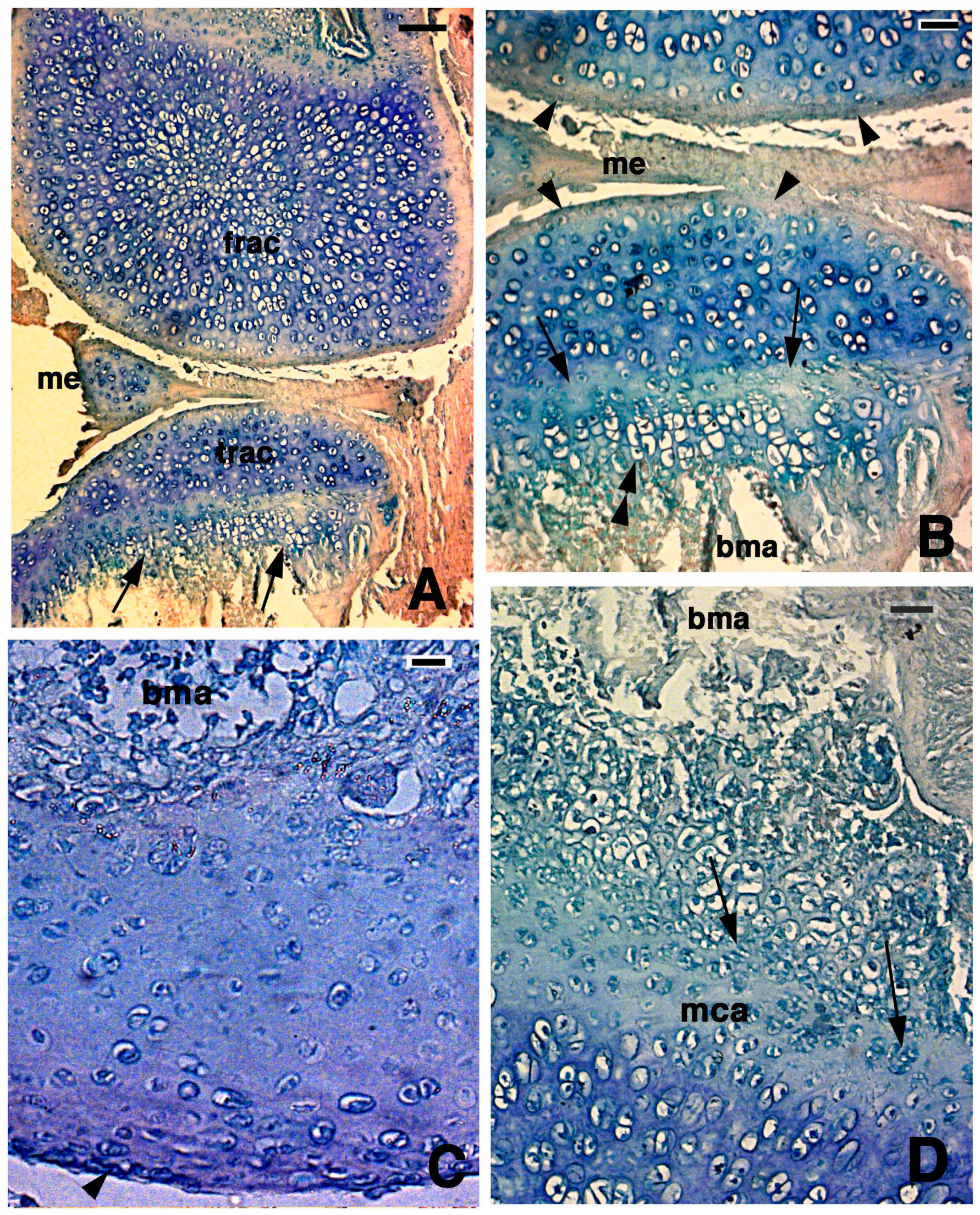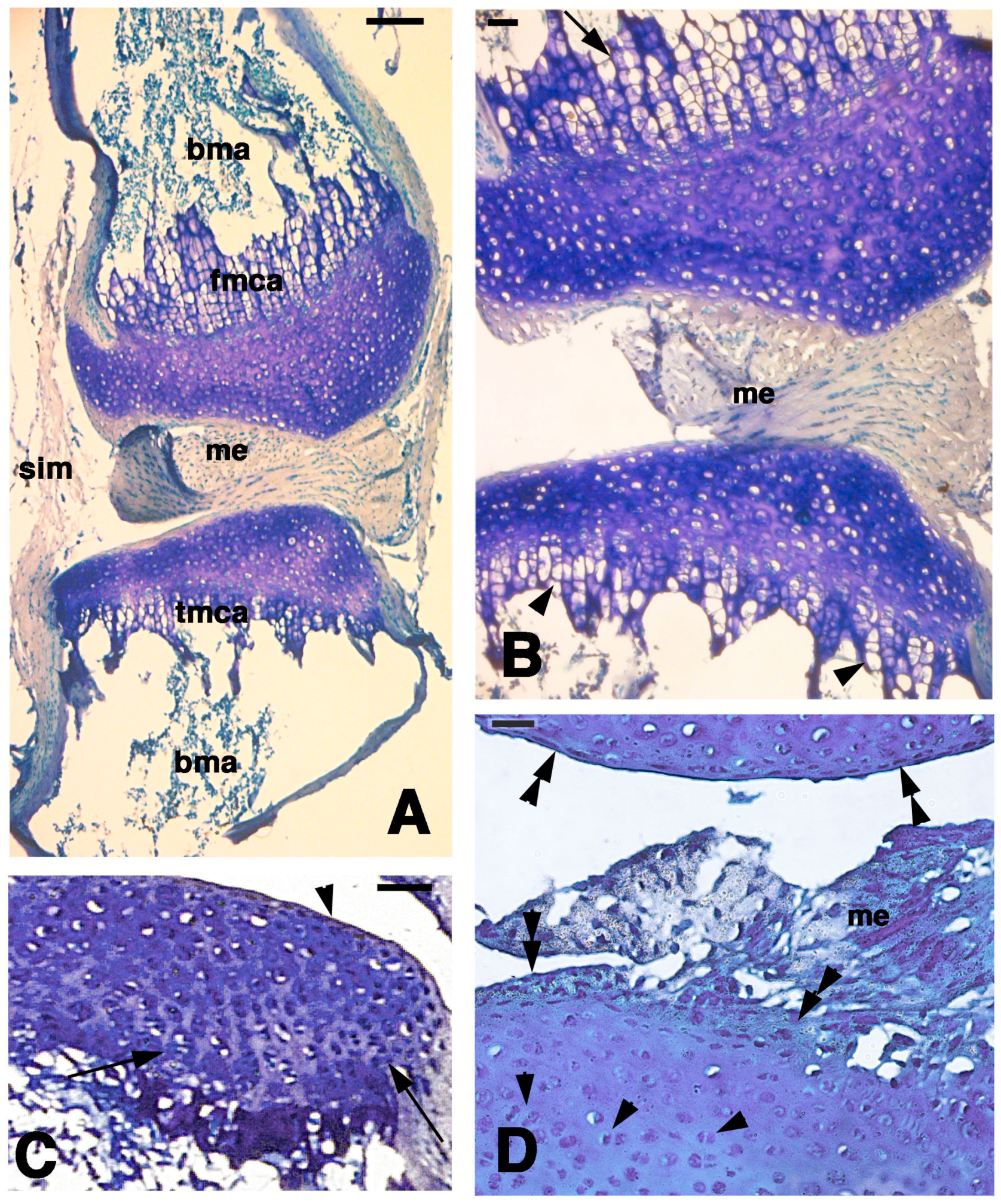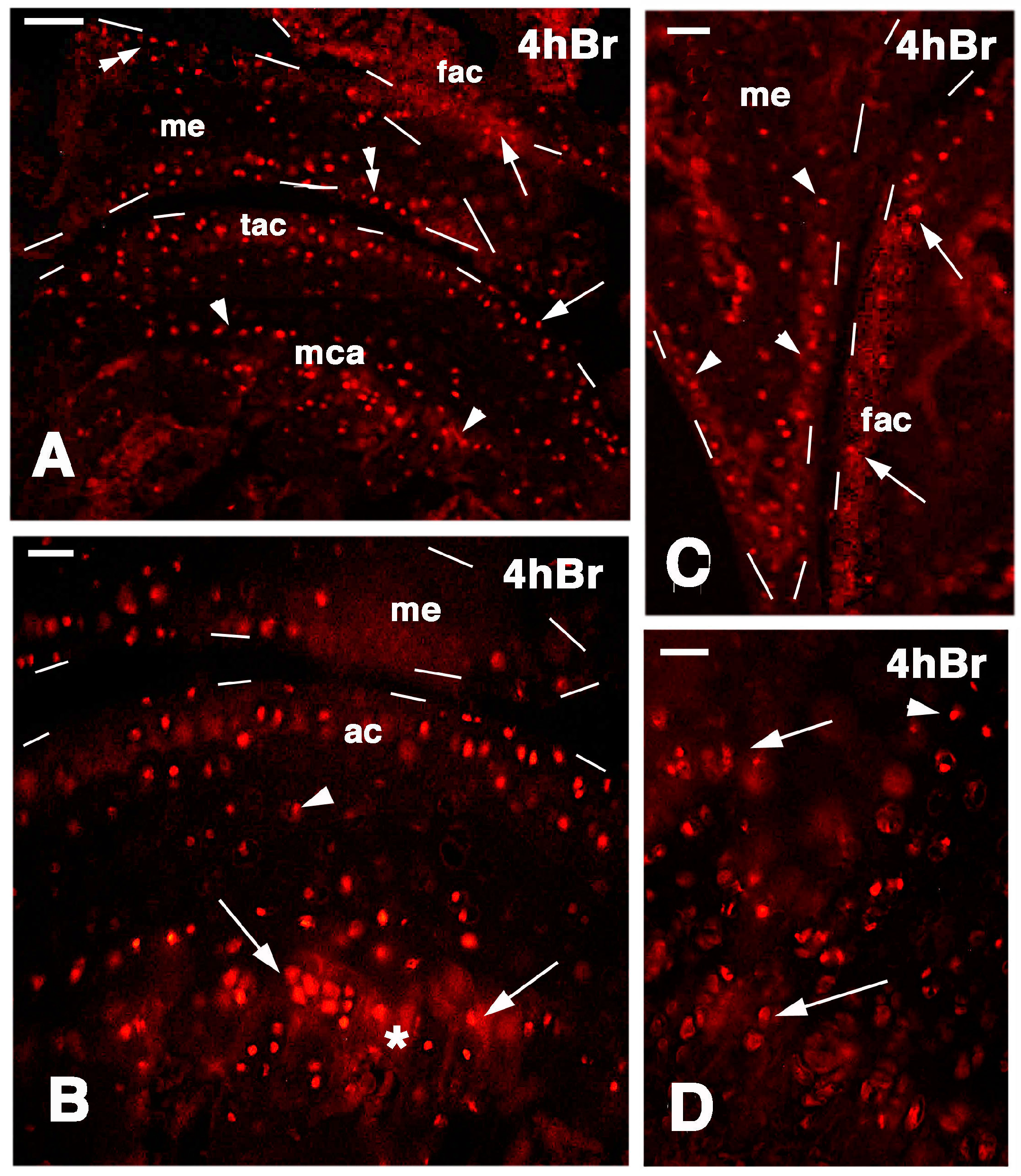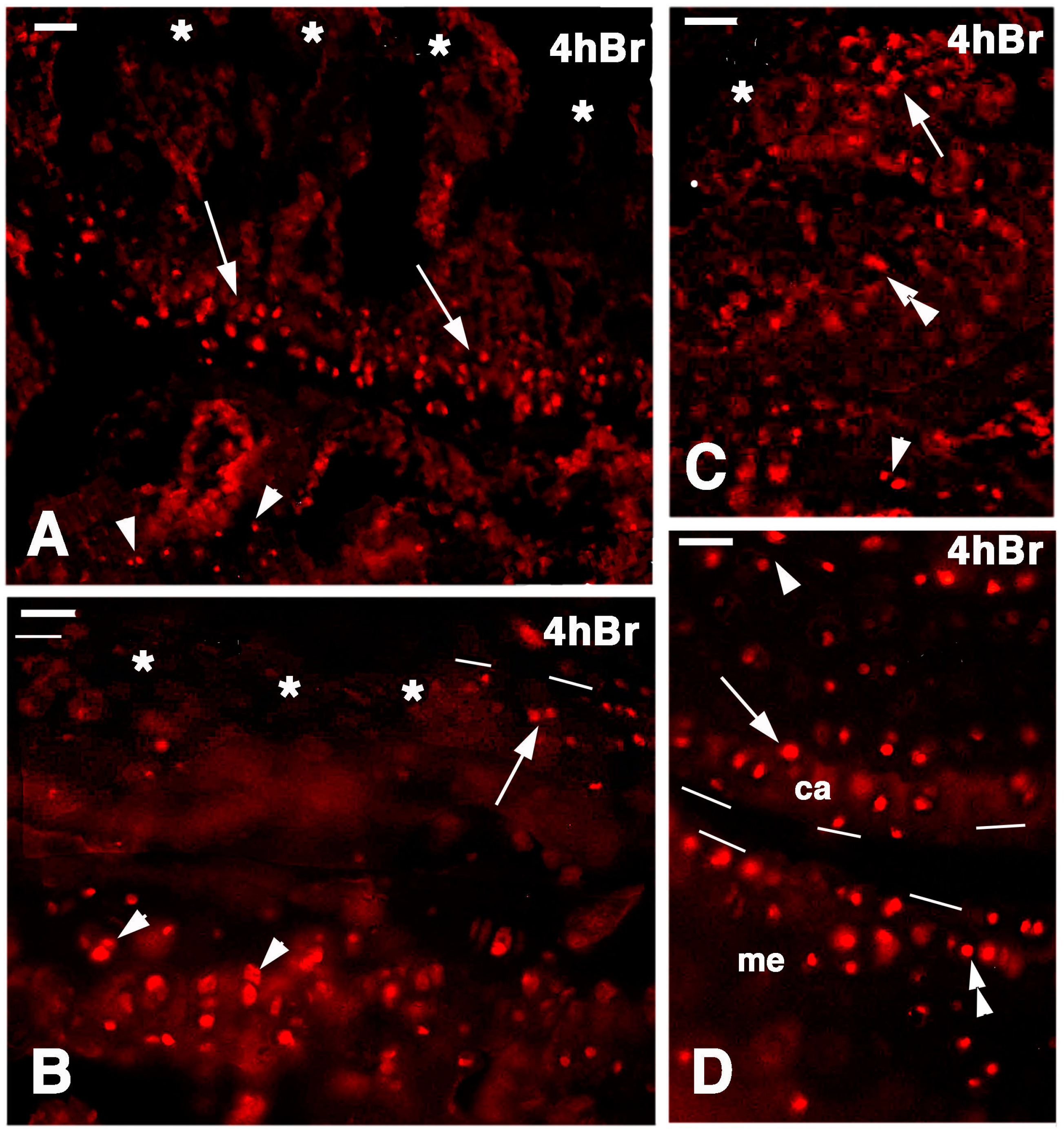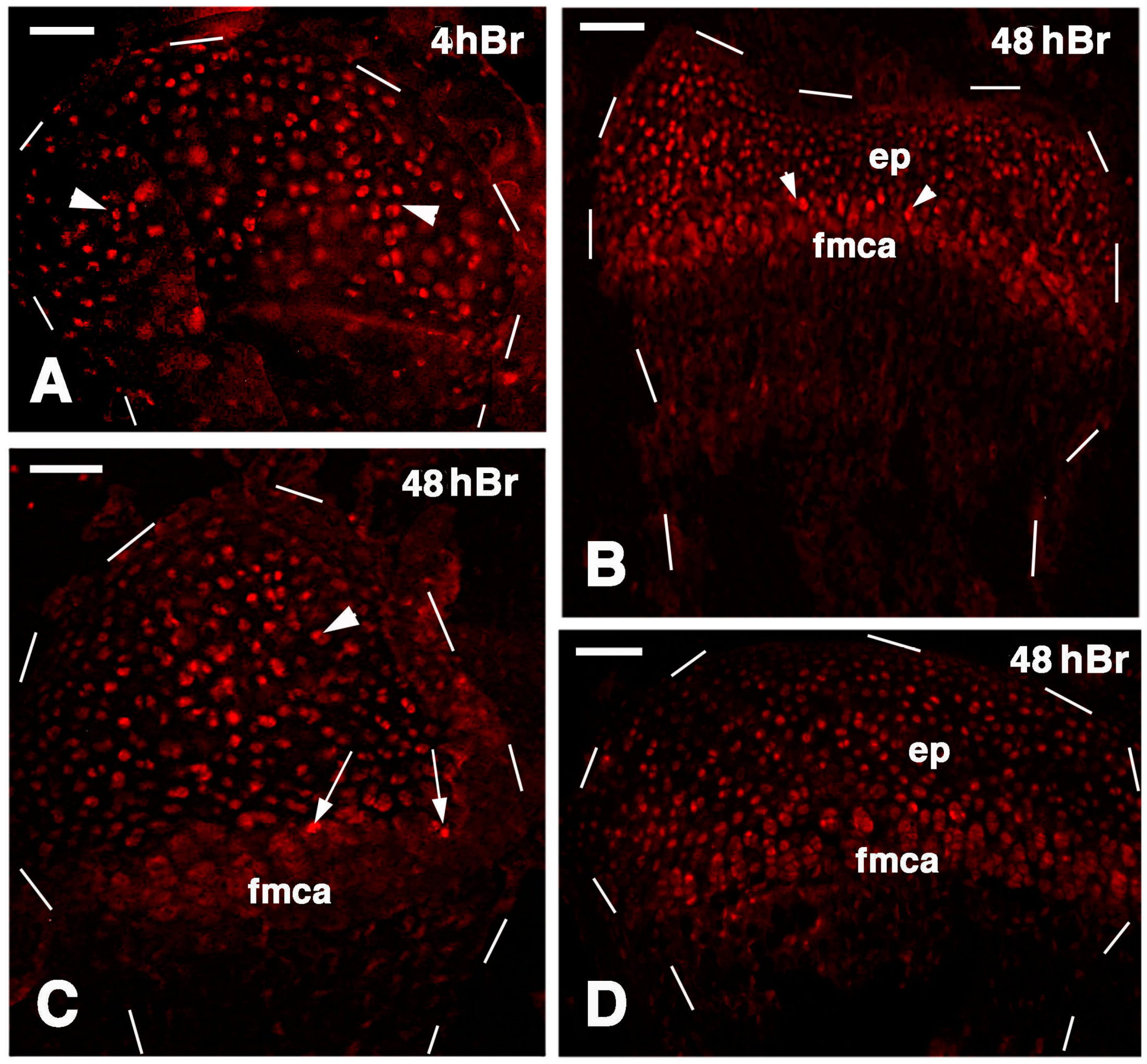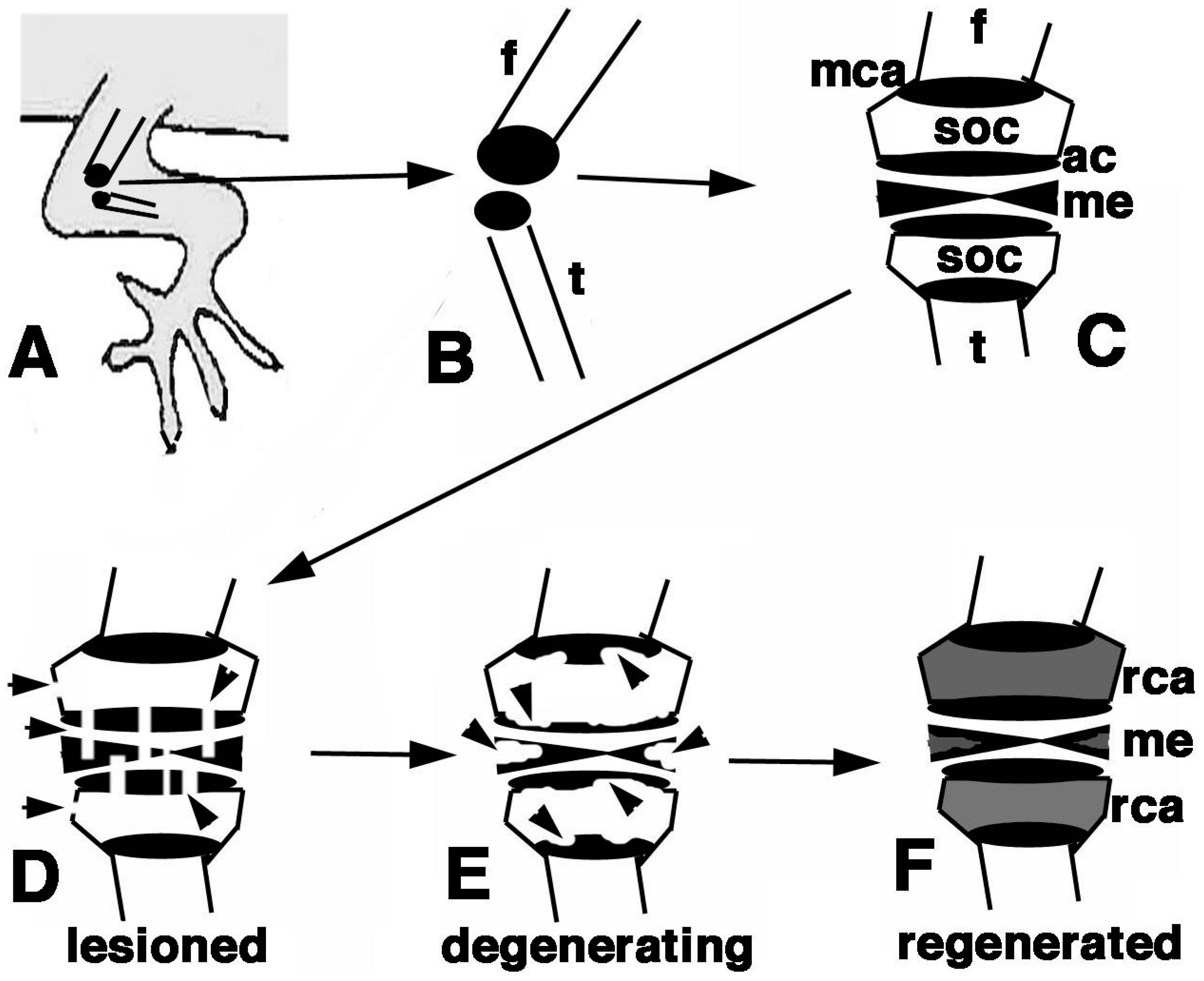3.1. Histology of the Epiphyses in the Normal Knee
The normal epiphysis of the femur and tibia showed a similar histological aspect (
Figure 1A). They consisted in a superficial layer of cartilaginous cells delimiting the epiphyseal outline and representing the articular cartilage that surrounded dorsally a marrow cavity of the secondary ossification center, made of bone trabeculae and blood marrow (
Figure 1A–D). Between the two opposed articular cartilages, a meniscus comprised a cartilaginous tissues in its lateral part that was connected to the medial part interposed between the two articular surfaces, consisting in a fibrous and dense regular connective (
Figure 1B).
In the ventral part of the secondary ossification center, a metaphyseal cartilage (growth plate) was present, and it separated the secondary ossification cavity from the endochondral bone cavity of the diaphysis (
Figure 1A,C). While the dorsal chondrocytes of the metaphyseal cartilage were irregularly arranged and discontinuous with the bone trabeculae (isotropic cartilage, see [
16]), the ventral chondrocytes tended to pile as is typical for the growth plate (anisotropic cartilage, see [
16]). However, the resting and proliferative zones were very limited, and the hypertrophic-piled chondrocytes rested on a discontinuous series of bony trabeculae (
Figure 1C,E). The articular cartilage, however, appeared irregularly thickened around the secondary ossification center (
Figure 1C) so that in some areas of the epiphysis this cartilage was actually merged with the metaphyseal cartilage (growth plate) located underneath, and the secondary ossification center appeared absent. The study at higher magnification of the articular cartilage showed the presence of flat and small chondrocytes on the superficial part. Beneath the superficial layer, chondrocytes assumed a rounded shape and enlarged forming isogenous groups in the deeper part that contacted the trabeculae of the secondary bone cavity. The latter formed an almost continuous bone lamina separating the articular cartilage from the bone marrow of the secondary ossification center (close-articular cartilage, see [
16]). In conclusion, the secondary ossification center varied both in shape and extension in the epiphysis, so that the center appeared as a large cavity in the medial sections and became narrow to disappear in more peripheral (tangential) sections where the cartilaginous tissue was thicker.
Figure 1.
Histology of the articular epiphysis of the normal knee. (A) General aspect of the articular cartilage of the femur (top) and the tibia (bottom) with their secondary ossification centers (arrows indicate the bone trabeculae). Bar, 100 µm; (B) Detail of the articular surfaces of the femur and tibia with interposed meniscus made of a fibrous part (arrowhead) and a cartilaginous part (lunula, arrow). Bar, 50 µm; (C) Another section of a tibia showing the irregular thickness of the articular cartilage (arrows) surrounding the secondary ossification center. Bar, 50 µm; (D) Detail of the superficial region of the articular cartilage of a tibia showing flat cells (arrow) contacting the sinovial cavity and the relatively abundant extracellular ground substance among the isogenous groups (arrowhead) located within the cartilaginous mass. Bar, 20 µm; (E) Detail on the metaphyseal (growth) plate featuring serial resting cartilage bounding the hypertrophic cartilage (arrows) contacting the diaphyseal bone (arrowheads indicate bone trabeculae). Bar, 20 µm. Legends: ac, articular cartilage; bma, bone marrow; dma, bone marrow of the diaphysis; fac, femur articular cartilage; me, meniscus, mca, metaphyseal (growth) cartilaginous plate; rca, resting cartilage within the metaphyseal plate; sim, sinovial membrane; soc, secondary ossification center; tac, tibia articular cartilage.
Figure 1.
Histology of the articular epiphysis of the normal knee. (A) General aspect of the articular cartilage of the femur (top) and the tibia (bottom) with their secondary ossification centers (arrows indicate the bone trabeculae). Bar, 100 µm; (B) Detail of the articular surfaces of the femur and tibia with interposed meniscus made of a fibrous part (arrowhead) and a cartilaginous part (lunula, arrow). Bar, 50 µm; (C) Another section of a tibia showing the irregular thickness of the articular cartilage (arrows) surrounding the secondary ossification center. Bar, 50 µm; (D) Detail of the superficial region of the articular cartilage of a tibia showing flat cells (arrow) contacting the sinovial cavity and the relatively abundant extracellular ground substance among the isogenous groups (arrowhead) located within the cartilaginous mass. Bar, 20 µm; (E) Detail on the metaphyseal (growth) plate featuring serial resting cartilage bounding the hypertrophic cartilage (arrows) contacting the diaphyseal bone (arrowheads indicate bone trabeculae). Bar, 20 µm. Legends: ac, articular cartilage; bma, bone marrow; dma, bone marrow of the diaphysis; fac, femur articular cartilage; me, meniscus, mca, metaphyseal (growth) cartilaginous plate; rca, resting cartilage within the metaphyseal plate; sim, sinovial membrane; soc, secondary ossification center; tac, tibia articular cartilage.
![Jdb 03 00071 g001]()
3.2. Histological Observations at Four and Seven Days Post-Lesion
After 4 days from time of the lesion, the two articular cartilages that were injured showed that a large portion of the cartilage was degenerated and that the extracellular matrix lost its basophilia while few basophilic chondrocytes remained visible among an eosinophilic and irregular fibrous dense connective tissue (
Figure 2A–D). The latter tissue likely resulted from the degeneration of chondrocytes and the disappearance of glycosominoglycans (GAGs) (evidenced by the loss of methylene blue stain), while the collagenous material remained in place, thereby conferring the prevalent eosinophilic stain. The signs of the lesion appeared as holes formed through the articular cartilage that penetrated into the secondary ossification center (
Figure 2B,C). Conversely, the methaphyseal cartilage was generally unaffected from the injury and most basophilia and cellular organization was conserved (
Figure 2C–E). The ligaments, meniscus and the surfaces of articular cartilages often appeared fragmented with irregularly displaced fibrous eosinophilic material, likely made of collagenous residual fibers while the proteoglycans are largely lost. The eosinophilic connective tissue replacing the cartilage contained sparse chondrocyte residual bodies, possibly representing pyknotic nuclei or condensed dead cells (see arrowheads in
Figure 2E). The detailed histological observation at higher magnification of the metaphyseal cartilage (growth plate) showed that the degenerating hypertrophic chondrocytes were not completely replaced by bone so that trabecolae were discontinuous underneath the cartilage (double arrowheads in
Figure 2E).
At 7 days post-lesion in some areas of the tibia and femur, there were regions of degenerated cartilage, just as there were at 4 days post-injury. Moreover, some areas with regenerating chondrocytes were seen (
Figure 3A). The degenerated cartilage consisted in an outer eosinophilic tissue facing the sinovial cavity and in a still basophilic area containing groups of roundish chondrocytes (
Figure 3B). The new cartilaginous tissue was formed by numerous roundish chondrocytes with scarce extracellular matrix and random disposition (
Figure 3C). Chondrocytes tended to occupy most of the new articular cartilage, still largely covered by remnants of the external degenerated cartilage that were attached to the ligaments (
Figure 3C,D). A line of flat chondrocytes, mimicking the superficial layer of a normal articular cartilage, was seen between the new basophilic cartilaginous cells and the degenerated eosinophilic cartilaginous tissue (arrows in
Figure 3C). Also, the new cartilage formed numerous irregular layers of chondrocytes that tended to merge with the metaphyseal plate. In the latter only a thin pale layer, made of acidophilic or damaged chondrocytes with no basophilia, was visible between the new articular cartilage and the adjacent methaphyseal (growth) plate (
Figure 3C,D). It also appeared that some cartilage regeneration also occurred in the meniscus.
3.3. Histology at Fourteen and Twenty-One Days Post-Lesion
At 14 days post-lesion, a large mass of regenerated, irregularly organized and small chondrocytes (isotropic cartilage) formed a large part of the epiphyses of both femur and tibia (
Figure 4A). Most of these cells were rounded and the amount of extracellular matrix separating chondrocytes was more abundant that the previous stage (
Figure 4B). In one case among those studied, some areas of the cartilaginous epiphyses showed chondrocytes directly contacting a mesenchymal tissue at the base of the epiphyses, possibly representing new bone marrow tissue (
Figure 4C). The formation of a serial cartilage where chondrocytes form piles of cells was missing. Only the more superficial chondrocytes, contacting the synovial articular cavity, appeared flat and less basophilic than the inner hyperthrophic chondrocytes.
Figure 2.
Histological aspects of the knee four days after the lesion. (A) The damaged ligaments, the meniscus, and the articular cartilages of the femur and tibia (arrows) are eosinophilic. Large part of the superficial articular cartilage has lost its basophilia to the methylene blue. The metaphyseal plates appear unchanged with respect to uninjured bones. Bar, 100 µm; (B) In this section, most of the basophilic articular cartilage has disappeared and is replaced by eosinophilic dense connective in continuation with bone trabeculae (arrowheads). The asterisk shows a hole in the degenerated cartilage corresponding to the point of lesion. Bar, 100 µm; (C) Detail on the hole (asterisk) bordered by completely eosinophilic degenerated cartilage (arrowhead) and a piece of cartilage showing some basophilia (arrow). The double arrowhead indicates the unchanged metaphyseal plate. Bar, 50 µm; (D) Detail showing the eosinophilic type of dense fibrous tissue (arrows) remained after cartilage degeneration on the femur (top arrows) and tibia (bottom arrows). Small regions containing basophilic chondrocytes remain. The arrowhead points to the basophilic metaphyseal plate. Bar, 50 µm; (E) Detail on the degenerated articular cartilage of a tibia showing an “island” of cartilaginous tissue (arrows) surrounded by small, possibly pyknotic cartilaginous cells (arrowheads). Double arrowheads indicate diaphyseal bone trabeculae. Bar, 25 µm. Legends: ac, articular cartilage; bma, bone marrow; lig, ligament; mca, metaphyseal (growth) plate.
Figure 2.
Histological aspects of the knee four days after the lesion. (A) The damaged ligaments, the meniscus, and the articular cartilages of the femur and tibia (arrows) are eosinophilic. Large part of the superficial articular cartilage has lost its basophilia to the methylene blue. The metaphyseal plates appear unchanged with respect to uninjured bones. Bar, 100 µm; (B) In this section, most of the basophilic articular cartilage has disappeared and is replaced by eosinophilic dense connective in continuation with bone trabeculae (arrowheads). The asterisk shows a hole in the degenerated cartilage corresponding to the point of lesion. Bar, 100 µm; (C) Detail on the hole (asterisk) bordered by completely eosinophilic degenerated cartilage (arrowhead) and a piece of cartilage showing some basophilia (arrow). The double arrowhead indicates the unchanged metaphyseal plate. Bar, 50 µm; (D) Detail showing the eosinophilic type of dense fibrous tissue (arrows) remained after cartilage degeneration on the femur (top arrows) and tibia (bottom arrows). Small regions containing basophilic chondrocytes remain. The arrowhead points to the basophilic metaphyseal plate. Bar, 50 µm; (E) Detail on the degenerated articular cartilage of a tibia showing an “island” of cartilaginous tissue (arrows) surrounded by small, possibly pyknotic cartilaginous cells (arrowheads). Double arrowheads indicate diaphyseal bone trabeculae. Bar, 25 µm. Legends: ac, articular cartilage; bma, bone marrow; lig, ligament; mca, metaphyseal (growth) plate.
![Jdb 03 00071 g002]()
Figure 3.
Histological aspects of the knee 7 days after the lesion. (A) Degenerating articular cartilage surface of the femur (arrowhead) while a region of regenerating cartilage is seen in the tibia (arrows) localized beneath the degenerated and eosinophilic articular cartilage with fragments of ligaments/meniscus. Bar, 100 µm; (B) Detail of the degenerated femur eosinophilic cartilage, in continuation with degenerating (pyknotic) chondrocytes (arrows). Also part of the metaphyseal plate appears to be degenerating (asterisk). Bar, 50 µm; (C) Detail on the ligament connection between the regenerated tibia cartilage (arrows) and the degenerating cartilage in the femur. Bar, 25 µm; (D) Case showing regeneration in the articular cartilage of the femur although a region of degenerated and chromophobic cartilage is still present in part of the metaphyseal plate. Bar, 25 µm. Legends: bma, bone marrow; dca, degenerated cartilage; lig, ligament; me, meniscus; mca, metaphyseal plate; soc, secondary ossification center.
Figure 3.
Histological aspects of the knee 7 days after the lesion. (A) Degenerating articular cartilage surface of the femur (arrowhead) while a region of regenerating cartilage is seen in the tibia (arrows) localized beneath the degenerated and eosinophilic articular cartilage with fragments of ligaments/meniscus. Bar, 100 µm; (B) Detail of the degenerated femur eosinophilic cartilage, in continuation with degenerating (pyknotic) chondrocytes (arrows). Also part of the metaphyseal plate appears to be degenerating (asterisk). Bar, 50 µm; (C) Detail on the ligament connection between the regenerated tibia cartilage (arrows) and the degenerating cartilage in the femur. Bar, 25 µm; (D) Case showing regeneration in the articular cartilage of the femur although a region of degenerated and chromophobic cartilage is still present in part of the metaphyseal plate. Bar, 25 µm. Legends: bma, bone marrow; dca, degenerated cartilage; lig, ligament; me, meniscus; mca, metaphyseal plate; soc, secondary ossification center.
![Jdb 03 00071 g003]()
Figure 4.
Histological aspects of the knee 14 days after the lesion. (A) In this case, the two apposed articular surfaces, femur at the top and tibia at the bottom, appear made of a highly cellular cartilaginous tissue. In the tibia, the beginning of a serial cartilage is present (arrows). Bar, 50 µm; (B) Close-up of the apposed articular cartilaginous surfaces where flat sinovial layers are present (arrowheads). The arrows indicate the presence of a likely resting and proliferating cartilaginous region where chondroblasts start to pile and form the hypertophic chondrocytes (double arrowheads). Bar, 20 µm; (C) Detail on the regenerated articular cartilage of the femur featuring flat superficial chondrocytes (arrowhead) and absence of piled condrocytes in contact with the bone marrow where the metaphyseal plate will reform later. Bar, 10 µm; (D) Detail of the more basophilic regenerated femur cartilage that confines with the proliferating region of a forming metaphyseal plate (arrows on some piled chondroblasts). Bar, 20 µm. Legends: bma, bone marrow; frac, femur regenerated articular cartilage; mca, metaphyseal plate; me, meniscus; trac, tibia regenerated articular cartilage.
Figure 4.
Histological aspects of the knee 14 days after the lesion. (A) In this case, the two apposed articular surfaces, femur at the top and tibia at the bottom, appear made of a highly cellular cartilaginous tissue. In the tibia, the beginning of a serial cartilage is present (arrows). Bar, 50 µm; (B) Close-up of the apposed articular cartilaginous surfaces where flat sinovial layers are present (arrowheads). The arrows indicate the presence of a likely resting and proliferating cartilaginous region where chondroblasts start to pile and form the hypertophic chondrocytes (double arrowheads). Bar, 20 µm; (C) Detail on the regenerated articular cartilage of the femur featuring flat superficial chondrocytes (arrowhead) and absence of piled condrocytes in contact with the bone marrow where the metaphyseal plate will reform later. Bar, 10 µm; (D) Detail of the more basophilic regenerated femur cartilage that confines with the proliferating region of a forming metaphyseal plate (arrows on some piled chondroblasts). Bar, 20 µm. Legends: bma, bone marrow; frac, femur regenerated articular cartilage; mca, metaphyseal plate; me, meniscus; trac, tibia regenerated articular cartilage.
![Jdb 03 00071 g004]()
In the other cases, the lowermost part of the regenerated cartilage, confining with the bone marrow cavity of the diaphysis, tended to form a new metaphyseal plate, as indicated by the association of chondroblasts in form of piles of cells (double arrowhead in
Figure 4B,D). The extracellular matrix surrounding the flat chondrocytes of the germinative area in the new metaphyseal plate was less basophilic than the new cartilage forming the remaining epiphyses, but the basophilia increased again in hypertrophic serial chondrocytes before calcification started.
Finally, at 21 days after lesion, the epiphyses of both femur and tibia appeared largely made of maturing cartilage (
Figure 5A). In one case, chondrocytes were irregularly distributed and numerous cells were hypertrophic and surrounded by an abundant and very basophilic matrix in the central part of these cartilaginous epiphyses, while they formed long piled metaphyseal plates in continuation with the bone marrow cavities of the diaphyses (
Figure 5B). In the other cases, the cartilage appeared more cellular, but chondrocytes tended to form piles of cells in the basal area of the epiphyses forming parallel isogenous groups (
Figure 5C). Superficial cells bordering the synovial articular cavity were typically flat while numerous recent isogenous groups were seen in the inner region of the articular cartilage (arrowheads in
Figure 5D).
Figure 5.
Histological aspects of the knee 21 days after the lesion. (A) General view of a case showing the apposed cartilaginous epiphyses with the meniscus. Bar, 100 µm; (B) Detail on the highly cellularized, regenerated articular cartilages where a metaphyseal plate is formed in both femur (top, arrow) and tibia (bottom, arrowheads). Bar, 25 µm; (C) Other case with regenerated articular cartilage containing flat superficial chondrocytes (arrowhead) and the beginning of formation of piled chondrocytes (arrows) in the forming metaphyseal cartilage. Bar, 50 µm; (D) detail of highly cellularized cartilage with numerous isogenous groups (arrowheads). Bar, 25 µm. Legends: bma, bone marrow; fmca, femur metaphyseal cartilage; me, meniscus; tmca, tibia cartilaginous methaphysis.
Figure 5.
Histological aspects of the knee 21 days after the lesion. (A) General view of a case showing the apposed cartilaginous epiphyses with the meniscus. Bar, 100 µm; (B) Detail on the highly cellularized, regenerated articular cartilages where a metaphyseal plate is formed in both femur (top, arrow) and tibia (bottom, arrowheads). Bar, 25 µm; (C) Other case with regenerated articular cartilage containing flat superficial chondrocytes (arrowhead) and the beginning of formation of piled chondrocytes (arrows) in the forming metaphyseal cartilage. Bar, 50 µm; (D) detail of highly cellularized cartilage with numerous isogenous groups (arrowheads). Bar, 25 µm. Legends: bma, bone marrow; fmca, femur metaphyseal cartilage; me, meniscus; tmca, tibia cartilaginous methaphysis.
3.4. Immunonocytochemical Observations
Four hours after injection of 5BrdU in the normal, uninjured knees, numerous labeled cells (nuclei) were seen on the surface layer of the articular cartilages of both femur and tibia. In addition, the meniscus contained labeled cells, especially along its surface (
Figure 6A–C). Sparse labeled cells were, however, also present inside the cartilage and in the bone marrow, especially contacting the labeled piled cells present in the metaphyseal (growth) plate, and representing resting and proliferating chondrocytes (
Figure 6D). Often the mineralizing matrix and the bone trabeculae located in the diaphysis non-specifically absorbed the fluorescent dye, and appeared more or less intensely fluorescent (asterisk in
Figure 6B).
Figure 6.
Immunolocalization of labeled cells in normal knee epiphyses 4 h post-injection of 5BrdU. Dashes outline the perimetry of the epiphesis and meniscus. (A) The main distribution of labeled cells is observed along the surface of the articular cartilages (arrows), in the metaphyseal plate (arrowheads), and along the meniscus surface (double arrowheads). Bar, 50 µm; (B) Detail on labeled cells in the more superficial part of the articular cartilage, and in the serial cartilage of the metaphyseal plate (arrows, the asterisk indicates a non-specific fluorescence around cells due to fluorofore absorption in the mineralizing matrix). Sparse labeled cells are seen in the intermediate region (arrowhead). Bar, 25 µm; (C) Other detail showing labeled cells in the femur articular cartilage (arrows) and meniscus (arrowheads). Bar, 25 µm; (D) Detail on the labeled cells within the serial cartilage (proliferating region) of the metaphyseal plate and germinal area (arrowhead). Bar, 25 µm. Legends: fac, femur articular cartilage; me, meniscus; mca, metaphyseal cartilage; tac, tibia articular cartilage.
Figure 6.
Immunolocalization of labeled cells in normal knee epiphyses 4 h post-injection of 5BrdU. Dashes outline the perimetry of the epiphesis and meniscus. (A) The main distribution of labeled cells is observed along the surface of the articular cartilages (arrows), in the metaphyseal plate (arrowheads), and along the meniscus surface (double arrowheads). Bar, 50 µm; (B) Detail on labeled cells in the more superficial part of the articular cartilage, and in the serial cartilage of the metaphyseal plate (arrows, the asterisk indicates a non-specific fluorescence around cells due to fluorofore absorption in the mineralizing matrix). Sparse labeled cells are seen in the intermediate region (arrowhead). Bar, 25 µm; (C) Other detail showing labeled cells in the femur articular cartilage (arrows) and meniscus (arrowheads). Bar, 25 µm; (D) Detail on the labeled cells within the serial cartilage (proliferating region) of the metaphyseal plate and germinal area (arrowhead). Bar, 25 µm. Legends: fac, femur articular cartilage; me, meniscus; mca, metaphyseal cartilage; tac, tibia articular cartilage.
![Jdb 03 00071 g006]()
At four days post-lesion, numerous labeled cells were still seen among the piled chondrocytes of the metaphyseal plate after 4 h post-injection of 5BrdU (
Figure 7A). Conversely, no labeled cells were localized in the degenerated areas of the articular cartilage or menisci (
Figure 7B). However, sparse labeled nuclei of chondrocytes were still seen in undamaged areas of the superficial, articular cartilage, especially in areas not hit by the lesion that maintained chondrocytes like in the normal, uninjured knee surfaces (
Figure 7C,D).
Figure 7.
Immunolocalization of labeled cells in 4-day lesioned knee epiphyses at 4 h post-injection of 5BrdU. Dashes outline the perimetry of the articular cartilage. (A) Numerous labeled cells (arrows) are still seen in the metaphyseal plate but not in the damaged superficial articular cartilage (asterisks). Arrowheads point to sparse labeled cells in the bone marrow of the diaphysis. Bar, 25 µm; (B) Detail of the labeled cells (arrowheads) present in the serial cartilage of the metaphysis that are absent in the superficial, damaged cartilage (asterisks) but are still seen in a confining region of relatively undamaged cartilage (arrow). Bar, 25 µm; (C) Area of relatively undamaged cartilage showing the presence of still labeled cells in the superficial part of the articular cartilage (arrow, the asterisk indicates the nearby damaged area). Sparse labeled cells are located in the intermediate region (double arrowhead) and by the metaphyseal plate (arrowhead). Bar, 25 µm; (D) Intact area of femur articular cartilage (ac) showing labeled cells (arrow), near the metaphyseal serial cartilage (arrowhead), and in the meniscus (me, double arrowhead). Bar, 25 µm.
Figure 7.
Immunolocalization of labeled cells in 4-day lesioned knee epiphyses at 4 h post-injection of 5BrdU. Dashes outline the perimetry of the articular cartilage. (A) Numerous labeled cells (arrows) are still seen in the metaphyseal plate but not in the damaged superficial articular cartilage (asterisks). Arrowheads point to sparse labeled cells in the bone marrow of the diaphysis. Bar, 25 µm; (B) Detail of the labeled cells (arrowheads) present in the serial cartilage of the metaphysis that are absent in the superficial, damaged cartilage (asterisks) but are still seen in a confining region of relatively undamaged cartilage (arrow). Bar, 25 µm; (C) Area of relatively undamaged cartilage showing the presence of still labeled cells in the superficial part of the articular cartilage (arrow, the asterisk indicates the nearby damaged area). Sparse labeled cells are located in the intermediate region (double arrowhead) and by the metaphyseal plate (arrowhead). Bar, 25 µm; (D) Intact area of femur articular cartilage (ac) showing labeled cells (arrow), near the metaphyseal serial cartilage (arrowhead), and in the meniscus (me, double arrowhead). Bar, 25 µm.
![Jdb 03 00071 g007]()
At seven days post-lesion in the regenerating areas or in the large cartilage at 14 days post-lesion, the regenerated cartilage of the epiphyses contained sparse labeled chondrocytes at 4 h post-injection of 5BrdU. These cells were present in the superficial cartilaginous layers but also inside the new cartilaginous tissue (
Figure 8A,B). In the latter, the formation of isogenous groups was noted within the cartilaginous mass, and some chondroblasts appeared labeled, indicating that an interstitial proliferation was taking place (
Figure 8C). Sparse labeled cells were also seen in the piled chondroblasts present in the forming metaphyseal plate (
Figure 8D). Control sections showed absence of labeled cells (nuclei) and a diffuse immunofluorescence in the mineralizing matrix around the chondrocytes of the metaphyseal plate (
Figure 8E).
Figure 8.
Immunolocalization of labeled cells in 14-day lesion tibia epiphyses (A,C), and 7-day lesion tibia (B,D) at 4 hours post-injection of 5BrdU. Dashes outline the perimetry of the articular cartilage. (A) Low magnification view of regenerated epiphyses (rep; dia, diaphysis) with labeled cells in the superficial (arrow) and inner (arrowhead) mass of cartilaginous cells. Bar, 50 µm; (B) Labeled cells in the superficial (arrow), inner cartilaginous mass (double arrowhead), and in the serial metaphyseal cartilage (arrowhead). Bar, 25 µm; (C) Detail on the labeled chondroblasts of isogenous groups (arrowheads) of regenerated cartilage. Bar, 25 µm; (D) Detail on labeled chondrocytes (arrow) within metaphyseal cartilage (the asterisks indicate non-specific fluorescence of the mineralizing matrix). Bar, 25 µm; (E) Control section of the metaphyseal cartilaginous (growth) plate (mac). Bar, 25 µm.
Figure 8.
Immunolocalization of labeled cells in 14-day lesion tibia epiphyses (A,C), and 7-day lesion tibia (B,D) at 4 hours post-injection of 5BrdU. Dashes outline the perimetry of the articular cartilage. (A) Low magnification view of regenerated epiphyses (rep; dia, diaphysis) with labeled cells in the superficial (arrow) and inner (arrowhead) mass of cartilaginous cells. Bar, 50 µm; (B) Labeled cells in the superficial (arrow), inner cartilaginous mass (double arrowhead), and in the serial metaphyseal cartilage (arrowhead). Bar, 25 µm; (C) Detail on the labeled chondroblasts of isogenous groups (arrowheads) of regenerated cartilage. Bar, 25 µm; (D) Detail on labeled chondrocytes (arrow) within metaphyseal cartilage (the asterisks indicate non-specific fluorescence of the mineralizing matrix). Bar, 25 µm; (E) Control section of the metaphyseal cartilaginous (growth) plate (mac). Bar, 25 µm.
A similar general labeling pattern was observed in the regenerated cartilaginous epiphyses of the femur and tibia at 21 days post-injury. In fact, 4 h after injection of 5 BrdU numerous labeled cells were irregularly distributed inside the cartilaginous mass and less frequently on the articular surface or in the metaphyseal plate (
Figure 9A). This suggested that most of the cartilage regeneration was interstitial more than appositional. Furthermore, at 48 hours post-injection of 5BrdU the number of intensely or less intensely labeled cells increased in the cartilage and metaphyseal plate, further suggesting the prevalence of an interstitial proliferation in addition to the less intense proliferation of the piled chondrocytes of the metaphyseal (growth) plate (
Figure 9B–D). Relatively few flat and labeled chondroblasts were seen on the synovial surface of the regenerated articular cartilage.
Figure 9.
Immunolocalization of labeled cells in 21 lesioned knee epiphyses 4 h post-injection of 5Brdu (A) and 48 h post-injection (B–D). Dashes outline the perimetry of the articular cartilage down to the diaphysis. (A) Tibia epiphyses formed by numerous labeled inner chondrocytes (arrowheads). Bar, 50 µm; (B) Sparse labeled cells in the femur epiphysis (ep) where the forming metaphyseal plate (fmca) also contains few clearly labeled cells (arrowheads). Bar, 50 µm; (C) Distributed labeled cells in a cartilaginous epiphyses (arrowhead) and in the forming metaphyseal plate (fmca, arrows) of a fibula. Bar, 50 µm; (D) Distributed labeled cells in the epiphysis (ep) and sparse labeled cells in the serial cartilage of the forming metaphyseal cartilage (fmca) of a tibia. 50 µm.
Figure 9.
Immunolocalization of labeled cells in 21 lesioned knee epiphyses 4 h post-injection of 5Brdu (A) and 48 h post-injection (B–D). Dashes outline the perimetry of the articular cartilage down to the diaphysis. (A) Tibia epiphyses formed by numerous labeled inner chondrocytes (arrowheads). Bar, 50 µm; (B) Sparse labeled cells in the femur epiphysis (ep) where the forming metaphyseal plate (fmca) also contains few clearly labeled cells (arrowheads). Bar, 50 µm; (C) Distributed labeled cells in a cartilaginous epiphyses (arrowhead) and in the forming metaphyseal plate (fmca, arrows) of a fibula. Bar, 50 µm; (D) Distributed labeled cells in the epiphysis (ep) and sparse labeled cells in the serial cartilage of the forming metaphyseal cartilage (fmca) of a tibia. 50 µm.
